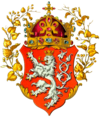Judith of Habsburg
This article includes a list of general references, but it lacks sufficient corresponding inline citations. (March 2012) |
| Judith of Habsburg | |
|---|---|
Queen consort of Poland | |
| Tenure | 1296–1297 |
| Born | 13 March 1271 Rheinfelden, Swabia |
| Died | 18 June 1297 (aged 26) Prague, Bohemia |
| Burial | Royal Crypt in St. Vitus Cathedral, Prague |
| Spouse | Wenceslaus II of Bohemia |
| Issue |
|
| House | Habsburg |
| Father | Rudolf I of Germany |
| Mother | Gertrude of Hohenberg |
Judith of Habsburg (
Early life
Judith was the youngest daughter of King
After King Ottokar's death, the Brandenburg margrave Otto V had guardianship over minor King Wenceslaus II, acting as Bohemian regent. After conflicts arose with Ottokar's widow Kunigunda of Halych, Margrave Otto temporarily held Wenceslaus as a prisoner at Bezděz Castle and in the Ascanian fortress of Spandau in Brandenburg. He did not return to Prague until 1283. As part of a reconciliation process, the formal engagement between Judith and Wenceslaus was renewed in 1279 at Jihlava; nevertheless, the bridal couple did not meet until in January 1285 a wedding ceremony was held by the Přemyslid and Habsburg dynasties in the City of Cheb (Eger).[2] The bride was given a dowry stretching "from the Duchy of Austria, Moravian border to the border of Danube". The ceremony in Cheb was followed by a "festive" wedding night, but soon after, King Rudolf took Judith back to Germany, since she was still of a young age. Moreover, the remarriage of Wenceslaus' mother Kunigunda to the Bohemian noble Záviš of Falkenstein appeared unacceptable to the king.
Queenship
Though Kunigunda died later in that year and Wenceslaus II had sworn an oath of
Upon her father's death in 1291, Judith further tried to reconcile her husband with her brother Albert, who struggled for the German throne with Count Adolf of Nassau.
Judith and Wenceslaus were finally crowned on 2 June 1297. Judith was not in good health at the time, having just given birth to her tenth child, which was stillborn. She died a few weeks after the coronation in Prague, at age twenty-six. She had been pregnant during much of her twelve years of marriage, giving birth almost once per year.
According to the family chronicles, Judith was described as beautiful, noble and virtuous. She supported her husband's claim on the Kingdom of Poland, where he ruled over the Seniorate Province at Kraków since 1291 and was able to succeed King Przemysł II in 1296.
Issue

Wenceslaus II and Judith had ten children:
- Přemysl Otakar (6 May 1288 – 19 November 1288).
- King of Poland.
- Agnes (6 October 1289 – after 1292 before 1306), twin of Wenceslaus III, betrothed to Rupert of Nassau, son of King Adolf of Germany, but died young.
- Anna (10 October 1290 – 3 September 1313), married in 1306 to Duke Henry of Carinthia.
- John I of Bohemia.
- Judith (3 March 1293 – 3 August 1294).
- John (26 February 1294 – 1 March 1295).
- John (21 February 1295 – 6 December 1296).
- Duke of Wrocław.
- Judith (born and died 21 May 1297).
Of the ten children only four lived to adulthood.
Family legacy
Wenceslaus III and then Anna and Elisabeth succeeded their father as rulers of Bohemia. Elisabeth was the mother of Charles IV, Holy Roman Emperor, his son was Sigismund, Holy Roman Emperor.
Judith is also an ancestor of
References
- ^ Earenfight 2013, p. 173.
- ^ Patrouch 2013, p. 30.
Sources
- Earenfight, Theresa (2013). Queenship in Medieval Europe. Palgrave Macmillan.
- Patrouch, Joseph F. (2013). "Bella gerant alii" Laodamia's Sisters, Habsburg Brides: Leaving Home for the Sake of the House". In Cruz, Anne J.; Stampino, Maria Galli (eds.). Early Modern Habsburg Women: Transnational Contexts, Cultural Conflicts, Dynastic Continuities. Routledge.

